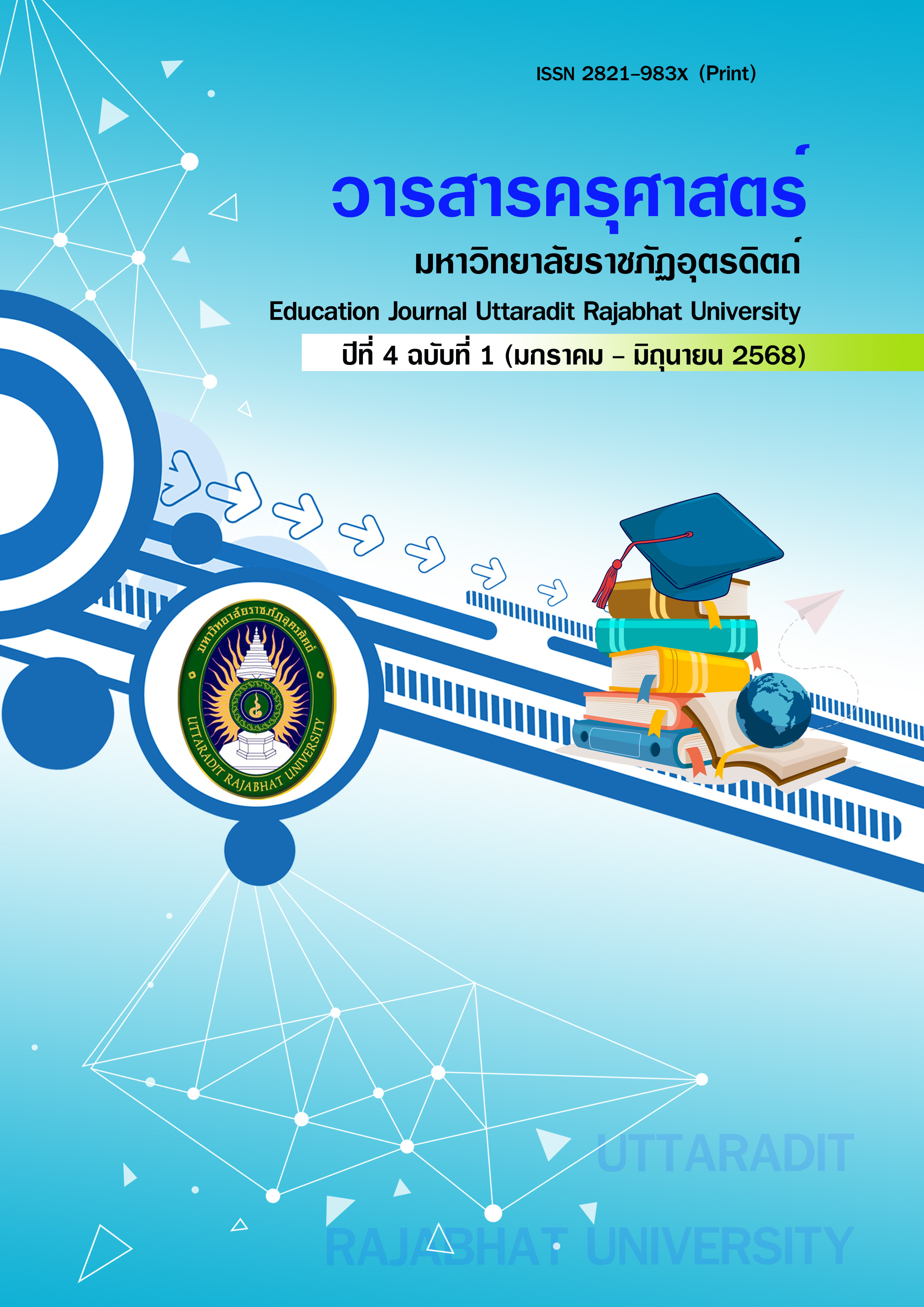Using Technological Media to Develop Mathematics Learning Achievement on Linear Inequalities with One Variable of 9th- grade Student at Phichai School, Uttaradit Province
Main Article Content
Abstract
This research has the following objectives: 1. To develop mathematics learning achievement on the topic of Linear Inequalities with One Variable of 9th- grade students by using technology-based media before and after learning in the classroom. 2. To study the satisfaction for grade 9th students towards learning mathematics on the topic of linear inequalities with one variable by technological media, conducted as classroom action research. With a sample group of 40 for grade 9th students from one classroom at Phichai School, Uttaradit Province, during the first semester of the 2024 academic year. The research tools used were mathematics learning management plans on the topic of linear inequalities with a single variable. The data collection tools included a mathematics achievement test and a satisfaction assessment form.
The research findings were as follows: 1.The mathematics learning achievement on the topic of linear inequalities with a single variable for grade 9th students was significantly higher after learning management at the statistical significance level of .05. 2. The grade 9th students had the highest level of satisfaction towards the mathematics learning management on the topic of linear inequalities with a one variable using technology-based media ( = 4.78, S.D. = 0.44)
Keywords: Technological media; Linear Inequality with One Variable; Achievement in mathematics
Article Details

This work is licensed under a Creative Commons Attribution-NonCommercial-NoDerivatives 4.0 International License.
Faculty of Education Journal Uttaradit Rajabhat University It is a medium for disseminating research results. Academic work Any opinions expressed in the article are solely the personal opinions of the author. Faculty of Education Uttaradit Rajabhat University and the editorial team does not necessarily have opinions that are consistent with those expressed in the article in any way. and is not considered the responsibility of the Faculty of Education Uttaradit Rajabhat University and editorial team
References
กระทรวงศึกษาธิการ.(2560).ตัวชี้วัดและสาระการเรียนรู้แกนกลางกลุ่มสาระการเรียนรู้คณิตศาสตร์ (ฉบับปรับปรุง พ.ศ.2560)ตามหลักสูตรแกนกลางการศึกษาขั้นพื้นฐาน พุทธศักราช2551. กรุงเทพฯ : โรงพิมพ์ชุมนุมสหกรณ์การเกษตรแห่งประเทศไทย.
ทิศนา แขมมณี. (2561). ศาสตร์การสอน : องค์ความรู้เพื่อการจัดกระบวนการเรียนรู้ที่มีประสิทธิภาพ (พิมพ์ครั้งที่ 22). กรุงเทพฯ : สำนักพิมพ์จุฬาลงกรณ์มหาวิทยาลัย, 2561.
ไพฑูรย์ สินลารัตน. (2560). ความเป็นครูและการพัฒนาครูมืออาชีพ. (พิมพ์ครั้งที่ 1). กรุงเทพฯ : สำนักพิมพ์แห่งจุฬาลงกรณ์มหาวิทยาลัย.
ลูกน้ำ แก้วปรีชา. (2563). การพัฒนากิจกรรมการเรียนรู้วิชาคณิตศาสตร์โดยใช้เกมร่วมกบการเรียนรู้แบบร่วมมือเทคนิคคิดเดี่ยว -คิดคู่-คิดร่วมกัน (Think-Pair-Share) ของนักเรียนชั้นประถมศึกษาปีที่ 6. [วิทยานิพนธ์ปริญญามหาบัณฑิต]. กรุงเทพฯ : มหาวิทยาลัยธุรกิจบัณฑิตย์.
วัชราภรณ์ บุญยรักษ์ และ คทาวุธ ชาติศักดิ์ยุทธ. (2562). การพัฒนาทักษะพื้นฐานทางด้านคณิตศาสตร์สำหรับเด็กปฐมวัยในจังหวัดอุตรดิตถ์โดยใช้ชุดกิจกรรมสร้างสรรค์ (รายงานการวิจัย). อุตรดิตถ์ : มหาวิทยาลัยราชภัฏอุตรดิตถ์.
สถานบันทดสอบทางการศึกษาแห่งชาติ(องค์การมหาชน). (2562-2564). สถิติ O-NET ย้อนหลัง สืบค้น 14 ธันวาคม 2567, จาก https://www.niets.or.th/th/content/view/11821
สุชาวดี พรมณี และ สมจิตรา เรืองศรี. (2563). การพัฒนาผลสัมฤทธิ์ทางการเรียนคณิตศาสตร์ ของนักเรียนชั้นมัธยมศึกษาปีที่ 3 เรื่อง อสมการเชิงเส้นตัวแปรเดียว โดยการเรียนรู้แบบร่วมมือ เทคนิคกลุ่มแข่งขัน(TGT). วารสารออนไลน์บัณฑิตศึกษา คณะศึกษาศาสตร์ มหาวิทยาลัยรามคำแหง.
สำนักงานคณะกรรมการการศึกษาขั้นพื้นฐานกระทรวงศึกษาธิการ. (2560). ตัวชี้วัดและสาระการเรียนรู้แกนกลางกลุ่มสาระการเรียนรู้คณิตศาสตร์ (ฉบับปรับปรุง พ.ศ. 2560) ตามหลักสูตรแกนกลางการศึกษาขั้นพื้นฐาน พุทธศักราช 2551. กรุงเทพฯ : โรงพิมพ์ชุมนุมสหกรณ์การเกษตรแห่งประเทศไทย จำกัด.
อรรถพล ศรัทธาผล และ สืบสกุล อยู่ยืนยง. (2566). การศึกษาผลการจัดกิจกรรมการเรียนรู้เรื่องอสมการเชิงเส้นตัวแปรเดียว โดยใช้เกมเป็นฐานของนักเรียนชั้นมัธยมศึกษาปีที่ 3 โรงเรียนท่ามะกาวิทยาคม จังหวัดกาญจนบุรี.วารสารวิชาการสถาบันพัฒนาพระวิทยากร, 6(3) : 158-168


